Dublin Southern District Tramways
History
A scheme for a horse tramway connecting Dublin, Blackrock, Kingstown (now Dún Laoghaire) and Dalkey was first mooted in late 1877, the main promoter being the Tramways and General Works Company Limited, which was looking to construct tramways around the British Isles. On the 28th June 1878, T&GWCoLtd set up a new London-based company — the Imperial Tramways Company Limited — to manage the tramways that it intended to build. One of the latter's directors was T M McKay, who was also chairman of the Dublin Tramways Company, strongly suggesting that he was also involved in the scheme.
Unfortunately for the promoters, the route paralleled that of the Dublin, Wicklow and Wexford Railway Company's main line, a concern that was prepared to use all and any means at its disposal to obstruct potential competition. The railway company almost certainly had a hand in limiting the powers that were granted to the tramway promoters (on the 4th July 1878) — under the Dublin Southern District Tramways Act, 1878 — as the central section of the tramway between Blackrock and Kingstown was excluded. Moreover, whilst the northern section of the tramway — between Dublin and Blackrock — was to be built to Irish Standard Gauge (i.e., 5ft 3ins), the section between Kingstown and Dalkey was limited to 4ft 0ins, ostensibly due to the narrowness of the thoroughfares. Quite why the promoters then saw fit to construct a tramway to two different gauges, and with the central section missing, is unclear.
The 4ft 0ins-gauge horse tramway was opened on the 17th March 1879, the standard-gauge tramway following on the 16th June 1879. The latter tramway connected to the tracks of the Dublin Tramways Company's standard-gauge system at Haddington Road. As the DSDTCo had yet to complete its stables and purchase the horses to operate this section, the initial services, which ran from Lower Abbey Street in Dublin right through to Blackrock, were worked using DTCo horses and crews. The DTCo's goodwill appears, however, to have quickly evaporated, such that by 1883 the DSDTCo was threatening to seek powers to operate over the tracks of its successor (the Dublin United Tramways Company) and into central Dublin. Although an agreement was subsequently reached between the two companies, which lasted from 1883 to 1893, this entailed a complete change of crew and horses at the boundary between the two systems, a procedure that was hardly designed with the travelling public's best interests in mind.
At its maximum, the two separate halves of the DSDTCo totalled 7.98 miles, most of it built on the single line and passing loop principle. The northern section ran southeastwards from Haddington Road, via Northumberland Road, Merrion Road and Rock Road, to a terminus in Main Street, Blackrock. It also included a short-lived branch westwards along Pembroke Road to Waterloo Road, which had been intended to meet the tracks of the DTCo in Upper Baggot Street, but which never did, probably due to the DTCo's uncooperative attitude. The southern section ran from a terminus on Royal Marine Road, near the DW&WRlyCo's Kingstown Station, southeastwards via Upper Georges Street, Glasthule Road, Breffni Road and Ulverton Road, to a terminus in Castle Street, Dalkey.
The DSDTCo experimented with steam traction between 1881 and 1884, and despite satisfying the inspecting officer, eventually gave up in the face of concerted opposition from the horse lobby, as well as from vested interests.
The two disparate sections of the DSDT were nominally joined up on the 16th July 1885, when the Blackrock and Kingstown Tramway Company opened a 5ft 3ins-gauge horse tramway between the two towns. In Blackrock, although the tracks of the two tramways were connected, the DSDTCo appears to have learned little from its experience at the hands of the DTCo, as through running apparently never took place. At the southern end of the tramway, where the tracks of the incompatible tramways were interlaced in Royal Marine Road, the two companies still managed to fall out over operational issues.
Here matters rested for the best part of a decade, anyone foolish enough to attempt a tramway journey from central Dublin to Dalkey having to change tramcars twice, as well as wait while the tramcar horses and crews were changed at Haddington Road. As a consequence, although moderately profitable, the DSDTCo was never a money spinner. The landscape changed in 1892 when the successful Bristol-based entrepreneur, George White (later Sir George), seized control of the Imperial Tramways Company, the DSDTCo's parent company. White had ambitious plans to electrify several of the ITCo's subsidiaries, and in particular the DSDT, quickly appointing James Clifton Robinson (later Sir James), a man with an impressive tramway pedigree, to the managership of the DSDTCo.
It is likely that the first step in the plan was to acquire the ailing Blackrock and Kingstown Tramways Company, which the ITCo probably did in 1892, given that plans were announced late that year to build an electric tramway between Dublin and Dalkey by converting the DSDT and the B&KT to the same gauge, and to overhead electric traction. Despite the inevitable opposition from the DW&WRlyCo, powers were obtained on the 24th August 1893 — under the Dublin Southern District Tramways Act, 1893— to acquire the B&KTCo, and to convert its lines and those of the DSDTCo to mechanical power.
It is unclear why work did not commence until early 1895, though it was possibly because difficulty was experienced in raising the necessary capital. In the end, the main electrical contractors — the British Thomson-Houston Company — were to receive a significant allocation of shares in the DSDTCo, purportedly giving them a controlling interest. Quite why George White, a shrewd investor if ever there was one, would have agreed to this is unclear.
Meanwhile, in late 1895, Clifton Robinson announced further plans to extend the DSDT into central and north Dublin, which would have created an electric tramway network to rival that of the DUTCo. The arrival of competition on the DUTCo's home turf was exactly the situation the company had feared (somewhat irrationally) for years, and which now put Clifton Robinson on a collision course with the DUTCo, and in particular, William Martin Murphy, a powerful voice in the city. The corporation was caught between the two companies, with many in the council favouring the 'English Company', i.e., the DSDTCo, over the DUTCo, which they viewed as a monopoly, over which they had insufficient control. Although both companies vied for the corporation's approval for their respective electrification schemes, the corporation was happy to play a waiting game, so deferred its decision.
The newly electrified DSDTCo line — from Haddington Road in Dublin to Dalkey — opened with great fanfare on the 16th May 1896, initially with twenty electric trams and twenty trailers. Despite the publicity and the genuine pride in an impressive technological achievement, behind the scenes, all was not well. In building the tramway, the BTHCo seems to have overreached itself financially, such that it was forced to enter voluntary liquidation shortly before the tramway opened, a new company of the same name being registered on the 18th May 1896, just two days after the opening; the major shareholder in the newly constituted BTHCo was General Electric.
The DSDTCo suffered a major blow two months later (on the 22nd July 1896) when its bill aimed at expanding its lines into Dublin was rejected. This development seems to have been anticipated by the new BTHCo, which sold its majority shareholding in the DSDTCo on the very same day to the DSDTCo's bitter rival, the DUTCo. Negotiations must have been going on for some time behind the scenes, which a shrewd businessman like George White must have been aware of, so he was in all likelihood unable to influence the BTHCo. This coup, which was engineered by William Martin Murphy, cost the DUTCo £243,000, but left them with a clear field as far as the electrification of the Dublin tramway system was concerned. A new company— Dublin United Tramways Company (1896) Limited — chaired by William Martin Murphy, was registered on the 28th September 1896 to take over the old DUTCo and the DSDTCo.
Although the DSDTCo was effectively taken over by the DUTCo on the 22nd July 1896, it was to take another eight years to sort out the legal niceties, as there was, at that time, no means by which a limited liability company (the new DUTCo) could take over a statutory company (the DSDTCo), accounts having to be kept separate until 1904.
Uniforms
Whilst the DSDTCo ran horse trams for just over 17 years, it would appear that only a single photograph has survived that depicts a driver and/or conductor reasonably clearly. What follows is therefore based on just a single piece of evidence, which is furthermore, not securely dated. This image suggests that horse-tram drivers, like many of their ilk across the British Isles, simply wore smart, informal attire (jacket and trousers), along with the horse driver's favoured headgear of the period, the bowler hat. Conductors appear to have been provided with uniform jackets, and kepi-style caps, the latter bearing a prominent cap badge, possibly of metal. As no examples of these cap badges have survived, it is unclear what they bore.
Fortunately, an excellent photograph survives that was taken on or around the opening day of the newly electrified line, which not only shows a number of conductors and a motorman, but also two inspectors. Assuming conductors and motormen wore the same uniforms (this is not entirely clear), jackets for both were single-breasted with four buttons (of unknown pattern) and lapels; the jacket collars carried insignia of some kind, very likely embroidered, and possibly comprising the system or company initials. The caps were of the kepi type with a stiff, horizontal peak; they bore an embroidered cloth cap badge, which by analogy with other ITCo tramways, as well as with the DUTCo (which appears to have copied the uniform — see link), probably bore company initials at the top and the grade at the bottom. The caps and the trousers were piped; documentary evidence indicates that the uniforms were dark blue and the piping white.
Inspectors wore typical tramway inspector garb, namely: single-breasted jackets edged in a finer material than the main body of the jacket, and closed with a hook and eye arrangement rather than buttons. The stand-up collars bore some kind of insignia, probably the grade. Unlike tramcar crews, inspectors were provided with drooping-peak caps, which bore a pompom on top, and an elaborate badge, again probably of embroidered cloth.
Further reading
For a short history of Dublin's tramways, see: 'Through Streets Broad and Narrow' by Michael Corcoran; Midland Publishing (2000). For a history of the DSDTCo, see: 'Dublin Southern District Tramways' by A T Newham, in the Tramway Review, Nos 46 (p138-144), 47 (p159-168) and 48 (p171-180); Light Railway Transport League (1966).
Images
Horse tram drivers and conductors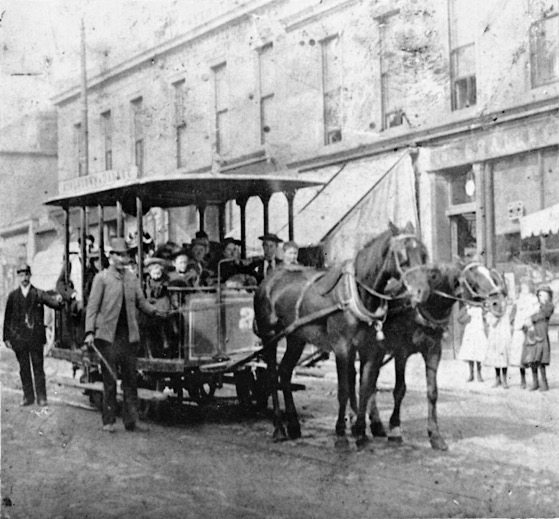
A very rare photo of a DSDTCo toastrack tram, positively identified from the route board on the roof, which reads: 'Kingstown & Dalkey'. The photo is thought to have been taken in the 1890s, though the headgear of the driver suggests that it may well have been taken earlier. The location is Upper Georges St, Kingstown. Photo courtesy of the Tramways and Light Railway Society, with thanks to David Voice.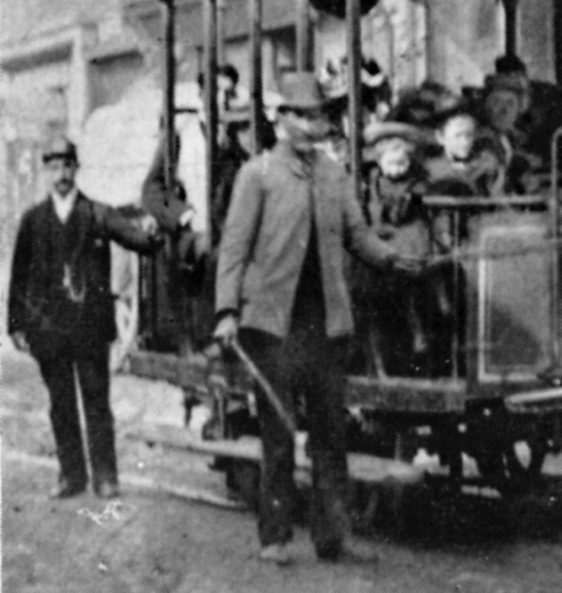
An enlargement of the above photograph, which though of poor quality, clearly shows that the driver is wearing informal attire, whilst the conductor has a kepi-style cap that bears a prominent cap badge; the latter's jacket may well have been company issued too.
Motormen and conductors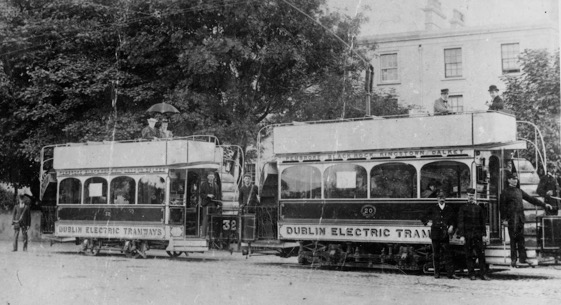
A view thought to have been taken on or around the opening day of the DSDT's electric services — 16th May 1896 — which probably explains the presence of two inspectors, and the pristine condition of the trams, unsullied by advertisements. The front vehicle (at the right) is No 20 and its trailer is No 32. Photo courtesy of Jim Kilroy, tram archivist at the National Transport Museum (see link).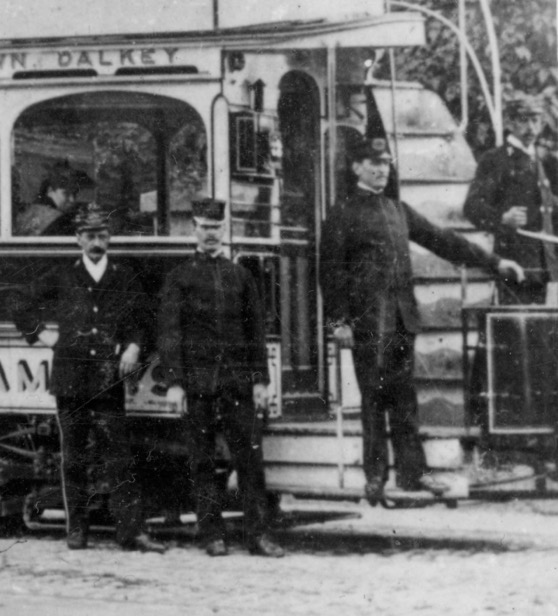
An enlargement of the above photograph showing a conductor, two inspectors and the motorman.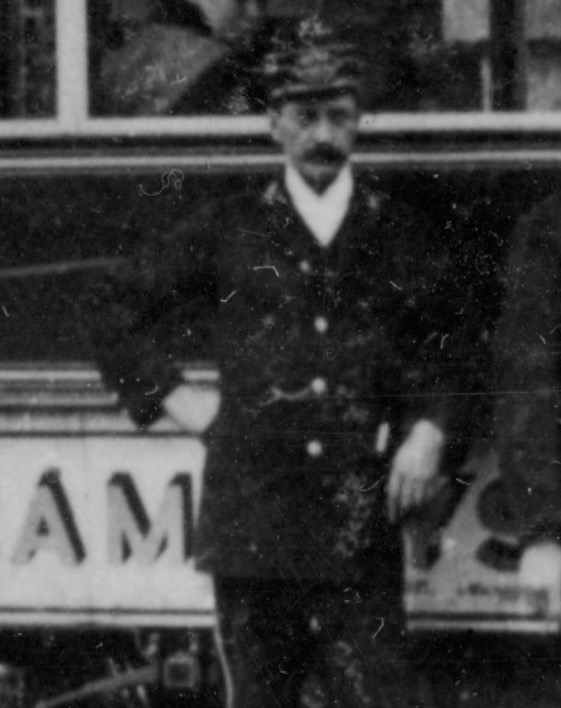
Another blow-up, this time showing the conductor; his kepi-style cap is piped and carries a prominent cap badge, an example of which is yet to come to light. Although the jacket and trousers are very similar — stylistically — to the later DUTCo uniforms, there are subtle differences, notably the use of collar insignia on the jacket and piping on the trousers.
Senior staff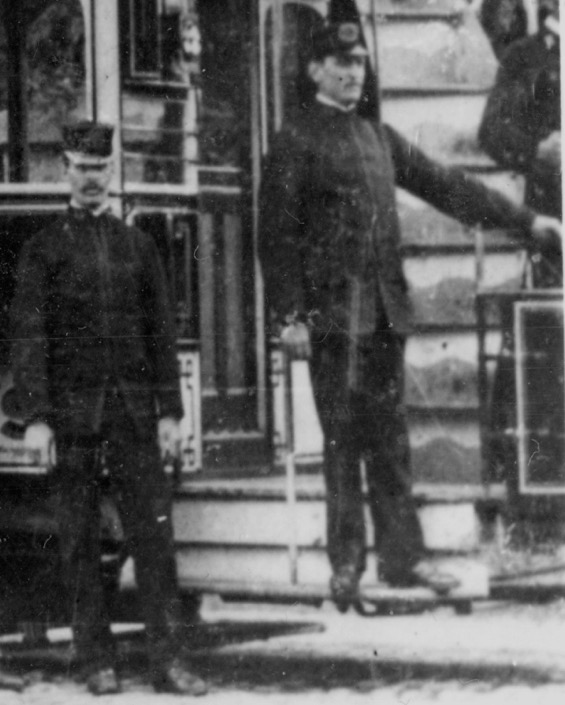
Another blow-up of the photo above, showing the two inspectors. Both of them are wearing typical tramway inspector apparel: single-breasted jackets with hook and eye fasteners, edged in a finer material than the main body of the jacket, and with drooping-peak caps topped by a pom pom. The collars carry some kind of insignia, very probably embroidered, whilst the caps carry a prominent cap badge. Whether the latter differed from the cap badges of conductors and motormen is unknown.